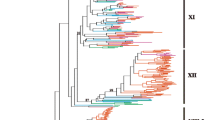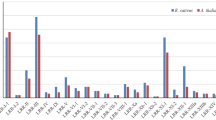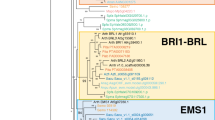Abstract
Leucine-rich repeat receptor-like kinases (LRR RLKs) comprise the largest group within the plant receptor-like kinase (RLK) superfamily, and the Arabidopsis genome alone contains over 200 LRR RLK genes. Although there is clear evidence for diverse roles played by individual LRR RLK genes in Arabidopsis growth and development, the evolutionary mechanism for this functional diversification is currently unclear. In this study, we focused on the LRRII RLK subfamily to investigate the molecular mechanisms that might have led to the functional differentiation of Arabidopsis LRR RLK genes. Phylogenetic analysis of 14 genes in this subfamily revealed three well-supported groups (I, II, and III). RT-PCR analysis did not find many qualitative differences in expression among these 14 genes in various Arabidopsis tissues, suggesting that evolution of regulatory sequences did not play a major role in their functional divergence. We analyzed substitution patterns in the predicted ligand-binding regions of these genes to examine if positive selection has acted to produce novel ligand-binding specificities, using the nonsynonymous/synonymous rate ratio (d N/d S) as an indicator of selective pressure. Estimates of d N/d S ratios from multiple methods indicate that nonsynonymous substitutions accumulated during divergence of the three lineages. Positive selection is likely to have occurred along the lineages ancestral to groups II and III. We suggest that positive selection on the ligand-binding sites of LRRII RLKs promoted diversification of ligand-binding specificities and thus contributed to the functional differentiation of Arabidopsis LRRII RLK genes during evolution.



Similar content being viewed by others
References
Alder MN, Rogozin IB, Lyer LM, Glazko GV, Cooper MD, Pancer Z (2005) Diversity and function of adaptive immune receptors in a jawless vertebrate. Science 310:1970–1973
Becraft PW (1998) Receptor kinases in plant development. Trends Plant Sci 3:384–388
Becraft PW (2002) Receptor kinase signaling in plant development. Annu Rev Cell Dev Biol 18:163–192
Brand U, Fletcher JC, Hobe M, Meyerowitz EM, Simon R (2000) Dependence of stem cell fate in Arabidopsis on a feedback loop regulated by CLV3 activity. Science 289:617–619
Braun DM, Walker JC (1996) Plant transmembrane receptors: new pieces in the signaling puzzle. TIBS 21:70–73
Canales C, Bhatt AM, Scott R, Dickinson H (2002) EXS, a putative LRR receptor kinase, regulates male germline cell number and tapetal identity and promotes seed development in Arabidopsis. Curr Biol 12:1718–1727
Cano-Delgado A, Yin Y, Yu C, Vafeados D, Mora-Carcia S, Cheng JC, Nam KH, Li J, Chory J (2004) BRL1 and BRL3 are novel brassinosteroid receptors that function in vascular differentiation in Arabidopsis. Development 131:5341–5351
Chevalier D, Batoux M, Fulton L, Pfister K, Yadav RK, Schellenberg M, Schneitz K (2005) STRUBBELIG defines a receptor-kinase-mediated signaling pathway regulating organ development in Arabidopsis. Proc Natl Acad USA 102:9074–9079
Clark SE, Williams RW, Meyerowitz EM (1997) The CLAVATA1 gene encodes a putative receptor kinase that controls shoot and floral meristem size in Arabidopsis. Cell 59:575–585
Clay NK, Nelson T (2002) VH1, a provascular cell–specific receptor kinase that influences leaf cell patterns in Arabidopsis. Plant Cell 14:2707–2722
De Lorenzo G, Ferrari S (2002) Polygalacturonase-inhibiting proteins in defense against phytopathogenic fungi. Curr Opin Plant Biol 5:295–299
Diévart A, Clark SE (2003) Using mutant alleles to determine the structure and function of leucine-rich repeat receptor-like kinases. Curr Opin Plant Biol 6:507–516
Diévart A, Clark SE (2004) LRR-containing receptors regulating plant development and defense. Development 131:251–261
Dixon MS, Hatzixanthis K, Jones DA, Harrison K, Jones JDG (1998) The tomato Cf-5 disease resistance gene and six homologs show pronounced allelic variation in leucine-rich repeat copy number. Plant Cell 10:1915–1926
Dodds PN, Lawrence GJ, Ellis JG (2001) Six amino acid changes confined to the leucine-rich repeat β-strand/β-turn motif determine the difference between the P and P2 rust resistance specificities in flax. Plant Cell 13:163–178
Ellis J, Jones D (1998) Structure and function of proteins controlling strain-specific pathogen resistance in plants. Curr Opin Plant Biol 1:288–293
Ellis JG, Lawrence GJ, Luck JE, Dodds PN (1999) Identification of regions in alleles of the flax rust resistance gene L that determine differences in gene-for-gene specificity. Plant Cell 11:495–506
Ellis J, Dodds P, Pryor T (2000a) The generation of plant disease resistance gene specificities. Trends Plant Sci 5:373–379
Ellis J, Dodds P, Pryor T (2000b) Structure, function and evolution of plant disease resistance genes. Curr Opin Plant Biol 3:278–284
Felsenstein J (1985) Confidence limits on phylogenies: an approach using the bootstrap. Evolution 39:783–791
Fontes EP, Santos AA, Luz DF, Waclawovsky AJ, Chory J. (2004) The geminivirus nuclear shuttle protein is a virulent factor that suppresses transmembrane receptor kinase activity. Gene Dev 18:2545–2556
Godiard L, Sauviac L, Torri KU, Grenon O, Mangin B, Grimsley NH, Marco Y (2003) ERECTA, an LRR receptor-like kinase protein controlling development pleiotropically affects resistance to bacterial wilt. Plant J 36:353–365
Goldman N, Yang Z (1994) A codon-based model of nucleotide substitution for protein-coding DNA sequences. Mol Biol Evol 18:360–369
Gómez-Gómez L, Boller T (2000) A LRR receptor-like kinase is involved in the perception of the bacterial elicitor, flagellin, in Arabidopsis. Mol Cell 5:1003–1011
Gómez-Gómez L, Bauer Z, Boller T (2001) Both the extracellular leucine-rich repeat domain and the kinase activity of FLS2 are required for flagellin binding and signaling in Arabidopsis. Plant Cell 13:1155–1163
Hecht V, Vielle-Calzada J, Hartog MV, Schmidt EDL, Boutilier K, Grossniklaus U, de Vries SC (2001) The Arabidopsis somatic embryogenesis receptor kinase 1 gene is expressed in developing ovules and embryos and enhances embryogenic competence in culture. Plant Physiol 127:803–816
Hunter T (1995) Protein kinase and phosphatase: the ying and yang of protein phosphorylation and signaling. Cell 80:225–236
Jinn TL, Stone JM, Walker JC (2000) HAESA, an Arabidopsis leucine-rich repeat receptor-kinase, controls floral organ abscission. Gene Dev 14:108–117
Jones DA, Jones JDG (1997) The role of leucine-rich repeat proteins in plant defenses. Adv Bot Res 24:90–167
Kinoshita T, Cano-Delgado A, Seta H, Hiranuma S, Fujioka S, Yoshida S, Chory J (2005) Binding of brassinosteroids to extracellular domain of plant receptor kinase BRI1. Nature 433:167–171
Kumar S, Tamura K, Jakobsen IB, Nei M (2001) MEGA2: Molecular Evolutionary Genetics Analysis software. Bioinformatics 17:1244–1245
Lehmann P (2002) Structure and evolution of plant disease resistance genes. J Appl Genet 43:403–414
Li J, Chory J (1997) A putative leucine-rich receptor kinase involved in brassinosteroid signal transduction. Cell 90:929–938
Li J, Wen J, Lease KA, Doke JT, Tax FE, Walker JC (2002) BAK1, an Arabidopsis LRR receptor-like protein kinase, interacts with BRI1 and modulates brassinosteroid signaling Cell 110:213–222
Llorente F, Alonso-Blanco C, Sanchez-Rodriguez C, Jorda L, Molina A (2005) ERECTA receptor-like kinase and heterotrimeric G protein from Arabidopsis are required for resistance to the necrotrophic fungus Plectophaerella cucumerina. Plant J 43:165–180
Mauricio R, Stahl EA, Korves T, Tian D, Kreitman M, Bergelson J (2003) Natural selection for polymorphism in the disease resistance gene Rps2 of Arabidopsis thaliana. Genetics 163:735–746
McDowell JM, Dhandaydham M, Long TA, Aarts MGM, Goff S, Holub EB, Dangl JL (1998) Intragenic recombination and diversifying selection contribute to the evolution of downy mildew resistance at the RPP8 locus of Arabidopsis. Plant Cell 10:1861–1874
Meyers BC, Shen KA, Rohani P, Gaut BS, Michelmore RW (1998) Receptor-like genes in the major resistance locus of lettuce are subject to divergent selection. Plant Cell 11:1833–1846
Michelmore RW, Meyers BC (1998) Clusters of resistance genes in plants evolve by divergent selection and a birth-and-death process. Genome Res 8:1113–1130
Mondragón-Palomino M, Meyers BC, Michelmore RW, Gaut BS (2002) Pattern of positive selection in the complete NBS-LRR gene family of Arabidopsis thaliana. Genome Res 12:1305–1315
Nam KH, Li J (2002) BRI1/BAK1, a receptor kinase pair mediating brassinosteroid signaling. Cell 110:203–212
Nei M, Gojobori T (1986) Simple methods for estimating the numbers of synonymous and nonsynonymous nucleotide substitutions. Mol Biol Evol 3:418–426
Nei M, Kumar S (2000) Molecular evolution and phylogenetics. Oxford University Press, New York, pp 51–71
Noel L, Moores TL, van der Biezen EA, Parniske M, Daniels MJ, Parker JE, Jones JDG (1999). Pronounced intraspecific haplotype divergence at the RPP5 complex disease resistance locus of Arabidopsis. Plant Cell 11:2099–2111
Osakabe Y, Maruyama K, Seki M, Satou M, Shinozaki, Yamaguchi-Shinozaki K (2005) Leucine-rich repeat receptor-like kinase1 is a key membrane-bound regulator of abscisic acid early signaling in Arabidopsis. Plant Cell 17:1105–1119
Page RDM (1996) Tree View. An application to display phylogenetic trees on personal computer. Comp Appl Biol Sci 12:357–358
Parniske M, Hammond-Kosack KE, Golstein C, Thomas CM, Jones DA, Harrison K, Wulff BBH, Jones JDG (1997) Novel disease resistance specificities result from sequence exchange between tandemly repeated genes at the Cf-4/9 locus of tomato. Cell 91:821–832
Richter TE, Ronald PC (2000) The evolution of disease resistance genes. Plant Mol Biol 42:195–204
Ronald PC (1998) Resistance gene evolution. Curr Opin Plant Biol 1:294–298
Rose LE, Bittner-Eddy PD, Langley CH, Holub EB, Wichelmore RW, Beynon JL (2004) The maintenance of extreme amino acid diversity at the disease resistance genes, RPP13, in Arabidopsis thaliana. Genetics 166:1516–1527
Saitou N, Nei M (1987) The neighbor-joining method: a new method for reconstructing phylogenetic trees. Mol Biol Evol 4:406–425
Shamrai SN (2003) Plant resistance genes: molecular and genetic organization, function and evolution. Zh Obshch Biol 64:195–214
Shanmugam V (2005) Role of extracytoplasmic leucine rich repeat proteins in plant defense mechanisms. Microbiol Res 160:83–94
Shiu S, Bleecker AB (2001) Receptor-like kinases from Arabidopsis form a monophyletic gene family related to animal receptor kinases. Proc Natl Acad Sci USA 98:10763–10768
Shpak ED, Lakeman MB, Torri KU (2003) Dominant-negative receptor uncovers redundancy in the Arabidopsis ERECTA leucine-rich repeat receptor-like kinase signaling pathway that regulates organ shape. Plant Cell 15:1095–1110
Shpak ED, McAbee JM, Pillitteri LJ, Torii KU (2005) Stomatal patterning and differentiation by synergistic interactions of receptor kinases. Science 309:290–293
Thomas CM, Jones DA, Parniske M, Harrison K, Balint-Kurti PJ, Hatzixanthis K, Jones JDG (1997) Characterization of the tomato Cf-4 gene for resistance to Cladosporium fulvum identifies sequences that determine recognitional specificity in Cf-4 and Cf-9. Plant Cell 9:2209–2224
Thompson JD, Higgins DG, Gibson TJ (1994) CLUSTAL W: improving the sensitivity of progressive multiple sequence alignment through sequence weighting, position-specific gap penalties and weight matrix choice. Nucleic Acids Res 22:4673–4680
Torri KU (2004) Leucine-rich repeat receptor kinases in plants: structure, function, and signal transduction pathways. Int Rev Cytol 234:1–46
Torri KU, Mitsukawa N, Oosumi T, Matsuura Y, Yokoyama R, Whittier RF, Komeda Y (1996) The Arabidopsis ERECTA gene encodes a putative receptor protein kinase with extracellular leucine-rich repeats. Plant Cell 8:735–746
Trotochaud AE, Jeong S, Clark SE (2000) CLAVATA3, a multimeric ligand for the CLAVATA1 receptor-kinase. Science 289:613–617
Walker JC (1994) Structure and function of the receptor-like protein kinases of higher plants. Plant Mol Biol 26:1599–1609
Walsh B (2003) Population-genetic models of the fates of duplicate genes. Genetica 118:279–294
Wang G.-L, Ruan D.-L, Song W.-Y, Sideris S, Chen L, Pi L.-Y, Zhang S, Zhang Z, Fauquet C, Gaut B, Whalen C, Ronald PC (1998) Xa21D encodes a receptor-like molecule with a leucine-rich repeat domain that determines race-specific recognition and is subject to adaptive evolution. Plant Cell 10:765–780
Wang ZY, Seto H, Fujioka S, Yoshida S, Chory J (2001) BRI1 is a critical component of a plasma-membrane receptor for plant steroids. Nature 410:380–383
Yang Z (1997) PAML: a program package for phylogenetic analysis by maximum likelihood. Comp Appl BioSci 13:555–556
Zhao DZ, Wang GF, Speal B, Ma H (2002) The EXCESS MICROSPOROCYTES 1 gene encodes a putative leucine-rich repeat receptor protein kinase that controls somatic and reproductive cell fates in the Arabidopsis anther. Gene Dev 16:2021–2031
Zhou A, Wang H, Walker JC, Li J (2004) BRL1, a leucine-rich repeat receptor-like protein kinase, is functionally redundant with BRI1 in regulating Arabidopsis brassinosteroid signaling. Plant J 40:399–409
Acknowledgments
We thank two anonymous referees for many constructive comments and suggestions. This project was supported by a NIH/NIGMS grant (No. 1S06GM60314).
Author information
Authors and Affiliations
Corresponding author
Additional information
[Reviewing Editor: Dr. Martin Kreitman]
Rights and permissions
About this article
Cite this article
Zhang, X.S., Choi, J.H., Heinz, J. et al. Domain-Specific Positive Selection Contributes to the Evolution of Arabidopsis Leucine-Rich Repeat Receptor-Like Kinase (LRR RLK) Genes. J Mol Evol 63, 612–621 (2006). https://doi.org/10.1007/s00239-005-0187-z
Received:
Accepted:
Published:
Issue Date:
DOI: https://doi.org/10.1007/s00239-005-0187-z




